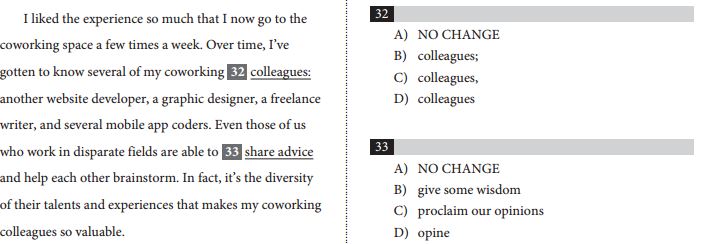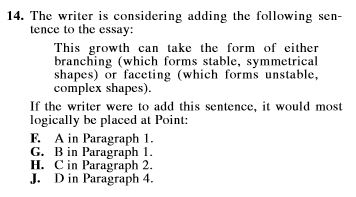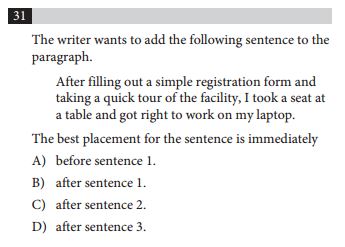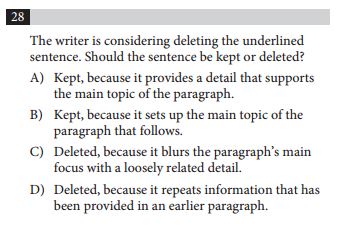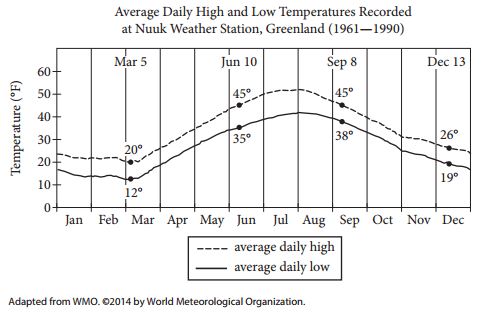Two Must-Have Skills for Acing the ACT Science Test
 Of the four ACT tests, the science test is the one about which I hear the most complaints:
Of the four ACT tests, the science test is the one about which I hear the most complaints:
“It’s not even about science.”
“That’s not what I learned in science class.”
And you know what? You’re right. The ACT science test is much more about interpreting information supplied in the scenarios and much less about how much you can recall from your sophomore year biology class.
Though you will need to have a plethora of skills at your disposal if you’re going to ace the science test, in this post we are going to share two that are critical. Use these two skills to simplify what can seem like difficult tables and graphs.
By my count, 21 of the 40 items on the latest ACT science test (2016-2017 Preparing-for-the-ACT Booklet) required using either a table or a graph. Fourteen of those 21 required students to decipher a graph or two; seven made them interpret a table. So, you can see these two skills affect at least one-half of your science score.
The examples used in this post are from the released ACT contained in the 2016-2017 Preparing-for-the-ACT Guide and are the property of ACT Inc, not 36 University.
Let’s get right to it!
Dissect the Tables
The ACT has a tendency to cram as much information as possible into a single table. This practice makes deciphering the tables difficult but crucial to maximizing your ACT score. Take a look:
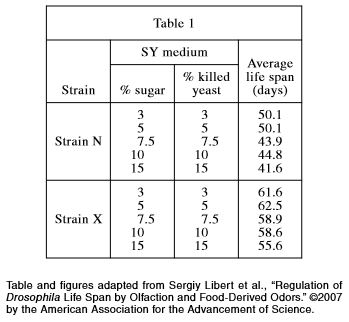
36U Must-Have Skill #1
The first column tells you WHO the table is about. The rest of the columns tell you WHAT information you are going to get about each WHO.
I see the table like this:
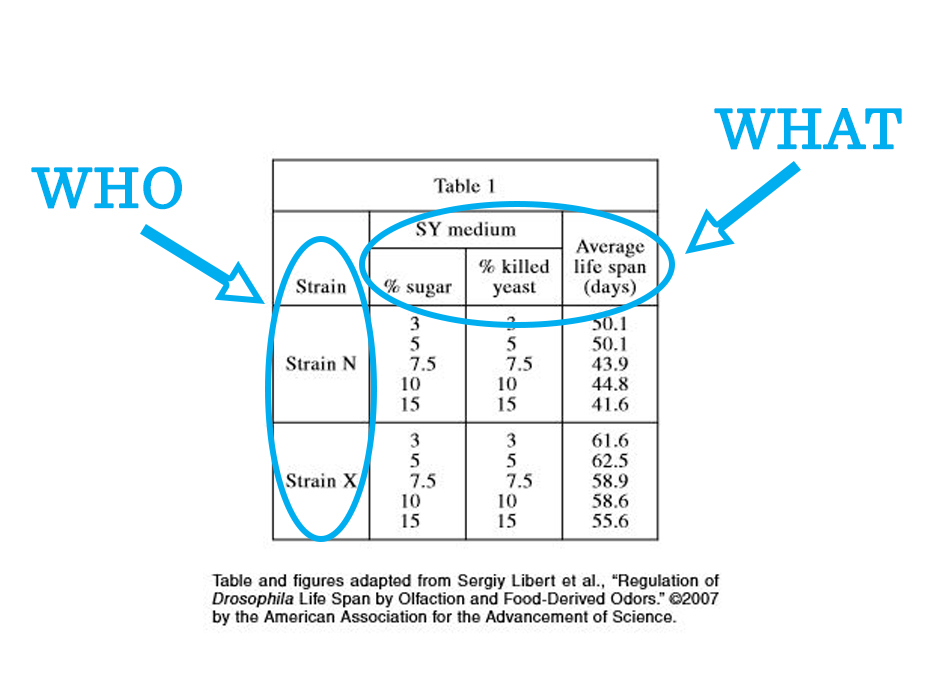
This table is about different strains of fruit fruits; that’s the WHO. The rest of the columns tell you about the % sugar, % killed yeast, and average life span; that’s the WHAT.
Let’s try a couple. Both of the questions can be answered from the table provided.

From the table, you should start in the Strain X row (WHO) and go over to the columns for % sugar and % killed yeast (WHAT). Twelve percent falls between 10% and 15%. Check the average life span column to estimate that the average life span would be between 55.6 and 58.6 days. Choose G.
Here’s another. You need to know that the text for this scenario tells you that Strain X fruit flies have impaired ability to detect odors. Strain N does not.

To answer this item, you’ll need the Strain X row and the Strain N row. Those are the WHO. From there, go to the column that is about average life span (WHAT). You can readily see that the average life span of Strain X fruit flies is longer than the life span of Strain N fruit flies. Choose C.
Disentangle the Graphs
Like the tables, the graphs are packed with data…
The ACT has no qualms placing multiple graphs on a single coordinate plane. Many times those extra graphs mean more horizontal and vertical axes, which makes interpreting the data even more difficult. Take your time: these graphs can be intimidating, but they are easily dissected.
36U Must-Have Skill #2
Find output values by tracing from the input value to the corresponding graph (use the key) and from there to the corresponding axis.
I’ll use an example from the same released ACT to show you what I mean:


Use the tip. Start at 8,000 years ago and trace up to the solar radiation graph (from key: dashed line). Take a left, because the solar radiation graph is on the left. The answer is 500 watts per square meter.
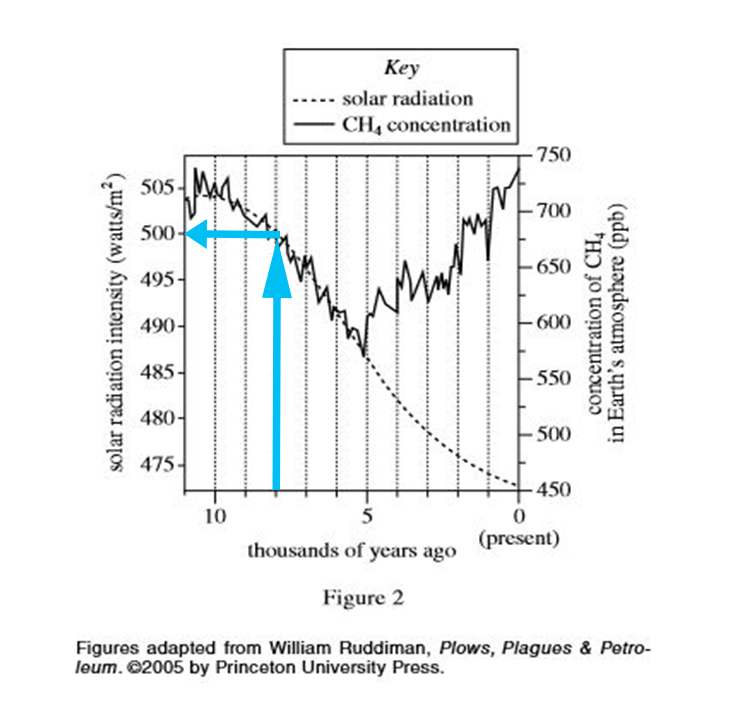
Thanks for checking out our tips. If you like the tips presented, please check out our entire ACT Prep program at 36university.com.
I hope you’ll find these tips helpful on your next ACT.
-Kendal Shipley, Ed.D.
12/9/2016
More 36U Resources:
36U Blog Posts
36U ACT Tips
36U ACT Prep Program
Side-by-Side Comparison of the Updated ACT and the New SAT

Wow! The SAT has changed. Instead of 10 smaller sections, now there are 4 bigger tests, just like the ACT. The SAT no longer penalizes for guessing. And the essay is now optional. It has even begun incorporating science items in the English and reading tests. To top it off, question formatting is very similar, too. Let’s get right to it…
(This post contains screenshots of items released by ACT Inc. and the CollegeBoard (makers of the SAT). The items are not the property of 36 University.)
Test Order and Structure: ACT vs SAT
Both tests have 4 main tests and an optional essay.
|
ACT |
SAT |
| Section 1 |
English (75 questions in 45 min) |
Reading (52 questions in 65 min) |
| Section 2 |
Math (60 questions in 60 min) |
Writing/Language (44 questions in 35 min) |
| Section 3 |
Reading (40 questions in 35 min) |
Math (20 questions in 25 min). Last 5 are grid-in. |
| Section 4 |
Science (40 questions in 35 min) |
Math (38 questions in 55 min). Last 8 are grid-in. |
| Section 5 (Optional) |
Writing (Optional Essay in 40 min) |
Essay (Optional in 50 minutes) |
| Total Time |
2 hrs 55 min or 3 hrs 35 min w/ Essay |
3 hrs or 3 hrs 50 min w/ Essay |
Scoring
|
ACT |
SAT |
| Max Score |
36 |
1600 |
| Details |
Each test has max score of 36.
Composite is average of four scores. |
SAT Reading max score: 800
SAT Reading derived from Reading & Writing/Language.
SAT Math max score: 800
SAT Math score derived from 2 math sections.
Composite is sum of Reading and Math scores. |
There is no penalty for wrong answers on either test.
Writing scores are kept separate from the other scores on both tests.
Subject Comparisons
ACT English vs SAT Writing/Language
The English tests on both the ACT and SAT have a very similar structure. The SAT English incorporates science graphs occasionally and seems to require a slightly more extensive vocabulary.
ACT Math vs SAT Math
|
ACT |
SAT |
| Setup |
60 questions in 60 minutes |
Part 1 (no calculator): 20 questions in 20 minutes (15 MC, 15 Free Response)
Part 2 (calculator): 38 questions in 55 minutes (30 MC, 8 Free Response) |
| Pace |
60 seconds per item |
Part 1: 60 seconds per item
Part 2: ~87 seconds per item |
| Question Format |
ACT Math has 5 answer choices. |
SAT Math has 4 answer choices on multiple choice questions.
SAT Math also has some Grid-In answer items. |
| Basic Items |
 |
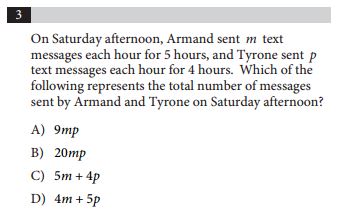 |
| Same Writers? |
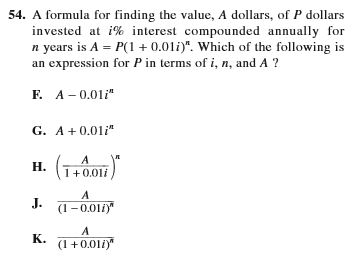 |
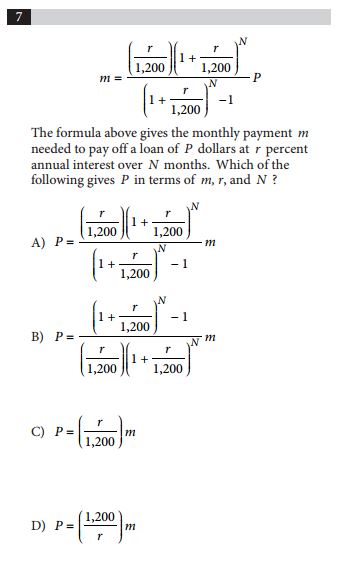 |
| Grid-Ins |
Not applicable. |

***Students grid-in answers on answer document. |
| Notes |
Calculator is allowed on all items. |
Calculator is allowed on Part 2, not Part 1. |
The math tests are not as similar as the English tests.
ACT Reading vs SAT Reading
|
ACT |
SAT |
| Setup |
40 questions divided over 4 passages
35 minutes |
52 questions divided over 5 passages
65 minutes |
| Pace |
52.5 seconds per item |
75 seconds per item |
| Passages |
4 passages:
Prose Fiction
Social Science
Humanities
Natural Science |
5 passages:
U.S. or World Lit
U.S. Constitution or Global Conversation
Social Science
2 Science passages |
| Comparison Items #1 |
 |
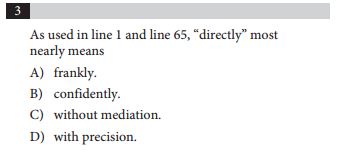 |
| Comparison Items #2 |
 |
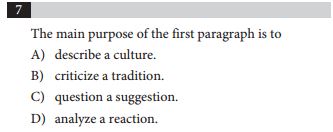 |
| Notes |
|
The SAT has begun adding items that require
students to locate justification in the text.

|
| Notes |
|
SAT Reading has science graphs included
in the 2 science passages.

|
As with the English tests, the Reading tests are very similar. On the SAT English tests, students will work with 2 science passages. On the ACT, the science is in a section on its own.
ACT Science in the SAT Writing and Reading
|
ACT |
SAT |
| Setup |
40 questions divided over 6 or 7 scenarios
35 minutes |
N/A |
| Pace |
52.5 seconds per item |
N/A |
| Question Format |
The ACT Science test requires students to interpret
information in tables and graphs.
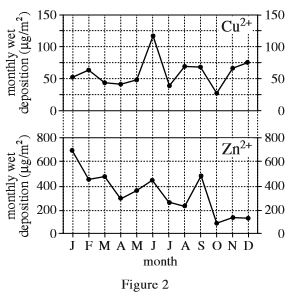
|
The tables and graphs are incorporated in the
SAT English and Reading tests.
|
| Basic Items |
Questions require students to evaluate
experiments and research.
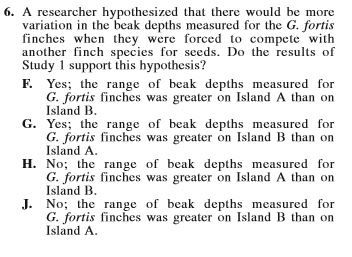
|
The tables and graphs are incorporated in the
SAT English and Reading tests. |
ACT Writing vs SAT Essay
|
ACT |
SAT |
| Setup |
1 essay in 40 minutes |
1 essay in 50 minutes |
| Format |
1 Central Question.
3 Perspectives Provided.
Students are asked to:
-state and develop their own position.
-analyze and evaluate the 3 perspectives
in light of their stated position. |
Students are given a relatively lengthy
passage to evaluate. Instead of stating
their own position, they are asked to dissect,
analyze, and evaluate the passage. |
| Examples |
You can find an example of an ACT Writing
test prompt provided by ACT Inc here:
Sample Prompt |
The Collegeboard has two sample prompts
available on its website:
Prompt 1
Prompt 2 |
Final Word
I don’t consider one test more difficult than the other, and the new SAT is new enough that I haven’t completed enough practice tests to make a complete assessment. At this point, maybe the most obvious difference between the tests is that 1/4 of the ACT score is derived from math items and 1/2 of an SAT score comes from math items.
Kendal Shipley, Ed.D.
6/3/2016
Recent and Related Posts
The Story of Lil Carl and the Arithmetic Series
Get a Copy of Your ACT and Fix the Mistakes
“Can you help me with test anxiety?” #30secondswiththeCEO
36U Blog List
36U ACT Tips
#30SecondswiththeCEO Videos List
36U ACT Prep Program
#1 Skill Needed to Score Well on the ACT May Be Reading Comprehension
Often, I hear from parents of students who have recently received ACT scores between 13 and 17. They are concerned that the low ACT score is going to limit their student’s college options and don’t know what skills to begin addressing.
Standardized tests don’t always accurately reflect what a student really knows or his capabilities, and sometimes students just have an off day on the day of the test.
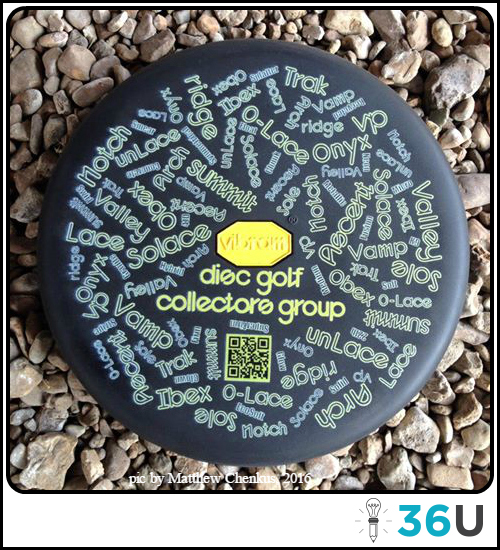
However, more often than not, low ACT scores are symptomatic of one prevailing problem: poor reading comprehension. A student who has weak reasoning and math skills may score poorly on the math and science tests. A student who doesn’t understand the basics of grammar and punctuation will likely score poorly in English. But the student who doesn’t read well will be penalized on all four subject tests. As strange as it may sound, many times low ACT scores can be traced back to a student’s ability to read and comprehend.
(All of the released ACT items below are from 2015-2016 Preparing-for-the-ACT Guide and are the property of ACT Inc., not 36 University.)
The English Test and Reading Comprehension
Examine the two items below. By my count, they are representative of 24 of the 75 English items from the 2015-2016 Guide, and they require strong reading comprehension skills! As you can see, a struggling reader will struggle with the English test.
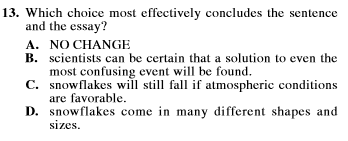
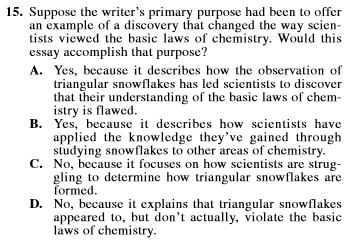
(If you missed our recent post The Juggling Act Required by the ACT, click here.)
The Math Test and Reading Comprehension
Maybe it’s not surprising that the English test requires strong reading skills, but the math test is text-heavy also. In fact, 39 of the 60 items from the 2015-2016 Preparing-for-the-ACT Guide required students to read at least 3 lines of text. Not all math items are like the three shown below, but many of them are.
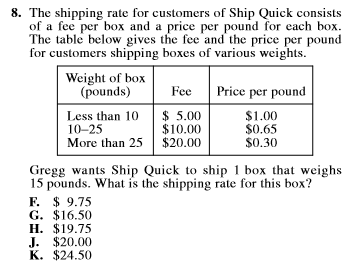
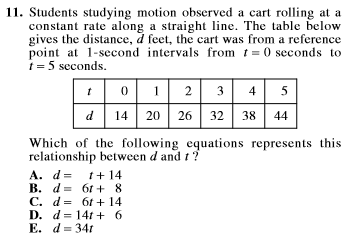
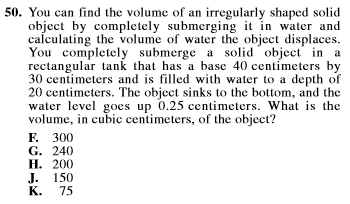
The Reading Test and Reading Comprehension
Of course, the reading test is all about reading comprehension, and it’s one-fourth of an ACT score! Sure, a fair number of the 40 items ask students to interpret meaning from what is explicitly stated in the text. However, a fair number also ask students to reason implicitly to determine inferences, main idea, compare and contrast, etc. It comes as no surprise that strong reading skills are required to score well on the reading test.
The Science Test and Reading Comprehension
To understand the importance of reading skills on the science test, you must first understand the test’s format. The science test consists of six or seven separate scenarios. One of those scenarios is comprised of only text, usually four or five paragraph’s worth. It is like a mini version of a reading scenario. All of the other scenarios require a significant amount of reading, too. In the 2015-2016 Preparing-for-the-ACT Guide, the other five passages accounted for another 19 paragraphs, almost 4 paragraphs per scenario.
To give you an idea of a typical ACT science passage, we have provided a sample passage from the same ACT publication we’ve used for this entire post:

Summary
As you can see, reading comprehension skills are needed on every section of the ACT. Scores in the 13 – 17 range are often a result of insufficient reading skills and not from a lack of content knowledge.
What Can I Do?
Be intentional! In your casual reading—through a news article, or your favorite blog, or that new novel—stop occasionally and ask yourself some very specific questions:
“What was the main idea of that paragraph?” (Try to summarize in 5 words or less.)
“Were the paragraph’s sentences presented in a logical sequence?”
“What was the main idea of the passage?”
“Were the paragraphs within the passage placed in a logical sequence?”
Intentionally evaluating and critiquing your reading material will make you a better reader and writer – and an improved ACT score will be a by-product of your new skills!
Recent and Related Posts
Get a Copy of Your ACT and Fix the Mistakes
The Juggling Act Required by the ACT English Test
3 Types of Probability Items to Expect on the ACT Math Test
36U Blog List
36U ACT Tips
36U ACT Prep Program
Your Week-Before-the-ACT Game Plan (Part 4 of 4: Science)
This is the final installment of our week-before-the-ACT game plan. Let us know how your game plan works on the big test!

The Setup
It’s nice to finish off the ACT with another shorter test. The Science Test, like the preceding Reading Test, will give you 40 minutes to answer 35 items. Those 35 items will be spread over 6 to 7 scenarios.
The Tables Have So Many Rows and Columns
Do you need to be reminded how complicated ACT Science tables can get? ACT is an expert at packing a ton of info into a single table. And the more information they put in a table, the more confusing and intimidating the table is likely to be.
Use one simple principle to read the tables efficiently: the first column almost always tells you WHO the table is about, and the rest of the columns tell you WHAT they are going to tell you about the WHO. Take the table below, for instance. The table is about different months. For each of those months, the table gives you the temperature, the pH, and the dissolved oxygen reading. This principle works no matter how difficult the table becomes.

And The Graphs Have So Many Plots and So Many Axes
Do they have to display so many relationships on a single graph? Along with multiple graphed relationships, you are often given multiple x- and y-axes. Yes, the graphs can get complicated in a hurry. Your ability to locate relevant information and interpret it will be crucial. Follow these two steps to simplify the process:
- Use the key to figure out which graph corresponds with which axis. In the graph below, you see the solid temperature graph corresponds with the axis on the left, and the dashed pH graph corresponds with the axis at the right.
- Be prepared to trace lines to find specific values. Can you find the pH level at the 5-minute mark? Start at the 5-minute mark and draw a line up to the solid pH line. From there, trace right to the pH axis. The pH is about 6.6.
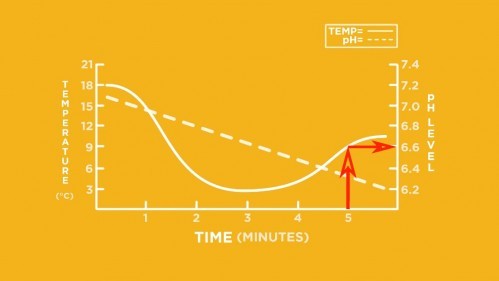
What About the Text-Only Passage?
The Conflicting Viewpoints scenario will be the only scenario comprised of only text. Several viewpoints will be presented. As you read the viewpoints, underline key details from each, making sure to note how they differ. You will be asked to differentiate between the perspectives.
A Game Plan
Read the introductory text of each scenario carefully. The text is used to explain the setting of the research or experiments. Understanding the setting is often critical to interpreting the tables and graphs correctly.
For each table, identify WHO the table is about and WHAT they are going to tell you about the WHOs. For graphs, note the input axis label (horizontal axis) and the output axis label (vertical axis) and check to see if there is a key. You will not likely need to spend any significant time reading the tables and graphs before you get to the questions. Use the questions to tell you where to focus on the tables and graphs.
Many of the more difficult items will require you to synthesize information from several pieces of the scenario. Information found in the text may be key to understanding a table. Data from two graphs may be required to answer a single item. Many times, these difficult items are found in the final few questions of a scenario.
Recent Posts:
Your Week-Before-the-ACT Game Plan (Part 3 of 4: Reading)
Your Week-Before-the-ACT Game Plan (Part 2 of 4: Math)
Your Week-Before-the-ACT Game Plan (Part 1 of 4: English)
 Of the four ACT tests, the science test is the one about which I hear the most complaints:
Of the four ACT tests, the science test is the one about which I hear the most complaints:








